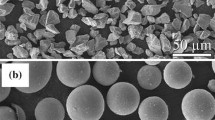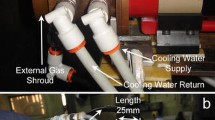Abstract
The bias voltage-enhanced plasma was utilized to investigate the compatibility of liquid tin and CPS (capillary porous system) in Sichuan University Plasma Surface Interaction (SCU-PSI). Prewetted (through static heating method) and unwetted (without preheating) Sn-CPS were prepared and then irradiated by different bias voltage-driven plasma. In comparison to bare CPS exposed to plasma, the Sn wetted CPS showed slightly internal and external morphology variation after plasma irradiation with + 20 V and − 20 V bias voltage. However, for unwetted Sn-CPS samples, the CPS revealed varying degrees of damage along with a range of bias voltage (0 V to − 16 V), which has not been observed before. It is interesting that there is no obvious surface structure change or damage for bare CPS after the irradiation of plasma and corrosion of liquid tin from other report. The inside mechanism still needs further investigation.






Similar content being viewed by others
Change history
21 August 2021
A Correction to this paper has been published: https://doi.org/10.1007/s42864-021-00115-4
References
Ivanova-Stanik I, Zagorski R. Influence of the divertor plate material on the plasma performance in DEMO. Nucl Fusion. 2015;5(7):073034.
Bolt H, Barabash V, Krauss W, Linke J, Neu R, Suzuki S, Yoshida N, ASDEX Upgrade Team. Materials for the plasma-facing components of fusion reactors. J Nucl Mater. 2004;329:66.
Budaev VP. Results of high heat flux tests of tungsten divertor targets under plasma heat loads expected in ITER and tokamaks (review). Phys Atom Nucl. 2016;79(7):1137.
Zhao M, Jacob W, Manhard A, Gao L, Balden M, Von TU, Zhou Z. Deuterium implantation into Y2O3-doped and pure tungsten: deuterium retention and blistering behavior. J Nucl Mater. 2017;487:75.
Xu Q, Ding XY, Luo LM, Miyamoto M, Tokitani M, Zhang J, Wu YC. D2 retention and microstructural evolution during He irradiation in candidate plasma facing material W-La2O3 alloy. J Nucl Mater. 2017;496:227.
Lang ST, Yan QZ, Sun NB, Zhang XX, Ge CC. Effects of TiC content on microstructure, mechanical properties, and thermal conductivity of W-TiC alloys fabricated by a wet-chemical method. Fusion Eng Des. 2017;121:366.
Nogami S, Guan WH, Fukuda M, Hasegawa A. Effect of microstructural anisotropy on the mechanical properties of K-doped tungsten rods for plasma facing components. Fusion Eng Des. 2016;109:1549.
Qi YF, Wang B, Zhou JY, Li YG, Tian W, Wang L. Research progress in damage of tungsten and tungsten-base materials for nuclear fusion device. Rare Metal Mat Eng. 2018;47(7):2262.
Antonov NV, Belan VG, Evtihin VA, Golubchikov LG, Khripunov VI, Korjavin VM, Lyublinski IE, Maynashev VS, Petrov VB, Pistunovich VI, Pozharov VA, Podkovirnov VI, Shapkin VV, Vertkov AV. Experimental and calculated basis of the lithium capillary system as divertor material. J Nucl Mater. 1997;1:1190.
Martin-Rojo AB, Oyarzabal E, Morgan TW, Tabares FL. Exposure of liquid lithium confined in a capillary structure to high plasma fluxes in PILOT-PSI-influence of temperature on D retention. Fusion Eng Des. 2017;117:222.
Morgan TW, Vertkov A, Bystrov K, Lyublinski IE, Genuit JW, Mazzitelli G. Power handling of a liquid-metal based CPS structure under high steady-state heat and particle fluxes. Nucl Mater Energy. 2017;12:210.
Kvon V, Al R, Bystrov K, Peeters FJJ, Van De Sanden MCM, Morgan TW. Tin re-deposition and erosion measured by cavity-ring-down-spectroscopy under a high flux plasma beam. Nucl Fusion. 2017;57(8):086040.
Ou W, Al RS, Vernimmen JWM, Brons S, Rindt P, Morgan TW. Deuterium retention in Sn-filled samples exposed to fusion-relevant flux plasmas. Nucl Fusion. 2020;60(2):026008.
Morgan TW, Rindt P, Van Eden GG, Kvon V, Jaworksi MA, Lopes Cardozo NJ. Liquid metals as a divertor plasma-facing material explored using the Pilot-PSI and Magnum-PSI linear devices. Plasma Phys Control Fusion. 2017;60(1):014025.
Lyublinski IE, Vertkov AV, Semenov VV. Comparative analysis of the possibility of applying low-melting metals with the capillary-porous system in tokamak conditions. Phys Atom Nucl. 2016;79(7):1163.
Coenen JW, De Temmerman G, Federici G, Philipps V, Sergienko G, Strohmayer G, Terra A, Unterberg B, Wegener T, Van den Bekerom DCM. Liquid metals as alternative solution for the power exhaust of future fusion devices: status and perspective. Phys Scr. 2014;2014(T159):014037.
Vertkov AV, Lyublinski IE, Zharkov MY, Mazzitelli G, Apicella ML, Iafrati M. Liquid tin limiter for FTU tokamak. Fusion Eng Des. 2017;117:130.
He PN, Zhang ZY, Xia WX, Shu L, Ma XC, Gou FJ, Zhang K. Compatibility between high-flux helium plasma irradiated molybdenum and liquid lithium. J Nucl Mater. 2018;509:736.
Cao X, Zhang DH, Zhao YJ, Xiao KG, Wei JJ, Chen SL, Ma XC, Gou FJ. Formulized average surface binding energy elevation and lithium vaporization and redeposition investigations in capillary pore systems. Nucl Fusion. 2019;59(5):056015.
Ye ZB, Ma XC, He PN, Wang ZJ, Liu QC, Yan Q, Wei JJ, Zhang K, Gou FJ. The investigation of plasma-induced wettability of liquid tin-capillary porous system. Nucl Mater Energy. 2019;20:100694.
Wang HX, Zhou Y, Gou FJ, Li Y, Wang HB, Zheng XJ, Li YG. Plasma density measurement on an SCU-PSI device via a CO2 dispersion interferometer. Plasma Fusion Res. 2018;13:3402049.
Ma XC, Cao XG, Han L, Zhang ZY, Wei JJ, Gou FJ. Characterization of high flux magnetized helium plasma in SCU-PSI linear device. Plasma Sci Technol. 2018;20:025104.
Fisher AE, Hvasta MG, Kolemen E. Study of liquid metal surface wave damping in the presence of magnetic fields and electrical currents. Nucl Mater Energ. 2019;19:101.
Pistunovich VI, Vertkov AV, Evtikhin VA, Korjavin VM, Lyublinski IE, Petrov VB, Khripunov BI, Shapkin VV. Research of the capillary structure heat removal efficiency under divertor conditions. J Nucl Mater. 1996;233:650.
Lyublinski IE, Vertkov AV, Zharkov MY, Sevryukov ON, Dzhumaev PS, Shumskiy VA, Ivannikov AA. Selection of materials for tokamak plasma facing elements based on a liquid tin capillary pore system. J Phys Conf Ser. 2016;748(1):012014.
Zhao P, Riesch J, Hoschen T, Almanstotter J, Balden M, Coenen JW, Himml R, Pantleon W, Toussaint UV, Neu R. Microstructure, mechanical behaviour and fracture of pure tungsten wire after different heat treatments. Int J Refract Met Hard Mater. 2017;68:29.
Yajima M, Yamagiwa M, Kajita S, Ohno N, Tokitani M, Takayama A, Saito S, Ito AM, Nakamura H, Yoshida N. Comparison of damages on tungsten surface exposed to noble gas plasmas. Plasma Sci Technol. 2013;15(3):282.
Lyublinski IE, Vertkov AV. Comparative assessment of application of low melting metals with capillary pore systems in a tokamak. Fusion Eng Des. 2014;89(12):2953.
Zheng XJ, Gou FJ, Zhou Y, Wang HX, Wallace AC, Wang HB, Huang ZH, Ji XQ, Liang SY, Liu W, Feng YT, Deng BQ. A pulsed high-current plasma beam under external and self-induced magnetic confinement in a linear device. Plasma Phys Control Fusion. 2019;61:105003.
Acknowledgements
This work was supported by the Fundamental Research Funds for the Central Universities (Grant No. 2019SCU12072), the China Postdoctoral Science Foundation (Grant No. 2019M663487), the National Natural Science Foundation of China (Grant No. 11875198 and 11905151) and the Major Research Plan of National Natural Science Foundation of China (Grant No. 91426303). Kun Zhang is grateful to the Fundamental Research Funds for the Central Universities for its financial support.
Author information
Authors and Affiliations
Corresponding authors
Additional information
Publisher's Note
Springer Nature remains neutral with regard to jurisdictional claims in published maps and institutional affiliations.
Rights and permissions
About this article
Cite this article
Ye, ZB., Ma, XC., He, PN. et al. Compatibility investigation of liquid tin and tungsten-based capillary porous system under high-density plasma environment. Tungsten 2, 94–100 (2020). https://doi.org/10.1007/s42864-020-00044-8
Received:
Revised:
Accepted:
Published:
Issue Date:
DOI: https://doi.org/10.1007/s42864-020-00044-8




